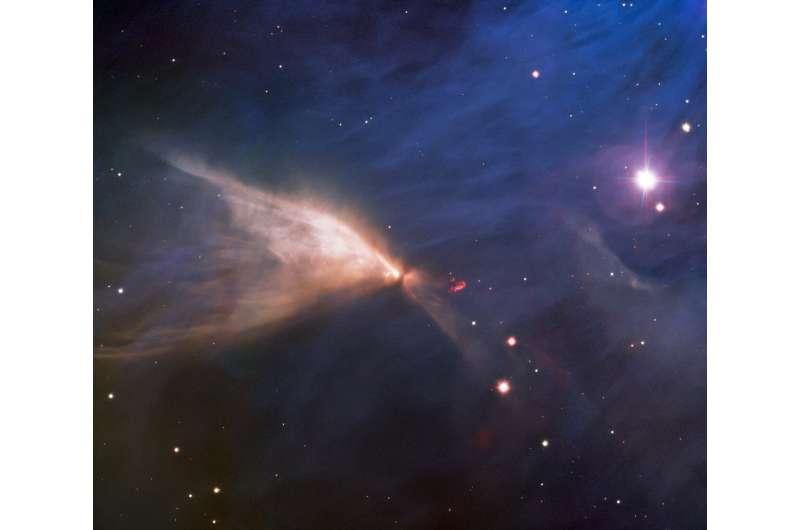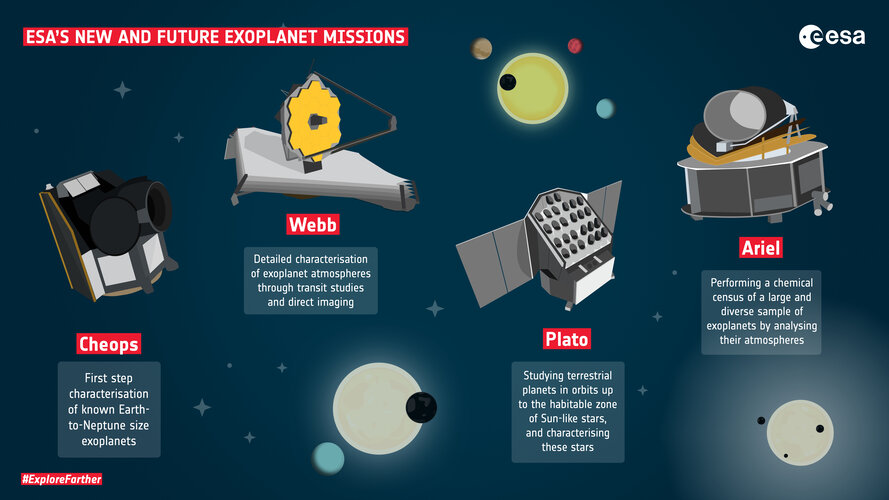
Copernical Team
Gemini South telescope catches a one-winged butterfly

Airbus will build ESA's Ariel exoplanet satellite

ESA and Airbus have signed a contract to move forward with the design and construction of the Atmospheric Remote-sensing Infrared Exoplanet Large-survey, Ariel, planned for launch in 2029.
Ariel is the third in a trio of dedicated exoplanet missions conceived by ESA focusing on various aspects of this rapidly evolving subject area. It will follow Cheops, which launched in 2019, and Plato, scheduled for launch in 2026.
Ariel will study the composition of exoplanets, how they formed and how they evolve, by surveying a diverse sample of about 1000 extrasolar planets, simultaneously in visible and infrared wavelengths.
It is the first mission dedicated to measuring the chemical composition and thermal structures of exoplanets, linking them to the host star's environment. This will fill a significant gap in our knowledge of how the planet's chemistry is linked to the environment where it formed, or if and how the type of host star drives the physics and chemistry of the planet's evolution.
JWST – A New View of the Universe
 Video:
00:04:00
Video:
00:04:00
The world’s next generation cosmic observatory, the James Webb Space Telescope, is due for launch on an Ariane 5 from Europe’s Spaceport in French Guiana in late December.
Developed and constructed over more than 30 years, Webb is a remarkable feat of engineering and technology – with the largest astronomical mirror ever flown in space, sophisticated new scientific instruments, and a sunshield the size of a tennis court.
Webb is a joint project between NASA, ESA, and the Canadian Space Agency and will reveal the Universe in a whole new light. Optimised for infrared wavelengths, its detectors will be
Japanese tycoon 'excited' ahead of trip to ISS

Japanese billionaire Yusaku Maezawa said Tuesday he was feeling "excited" ahead of his mission to the International Space Station, which marks Russia's return to space tourism.
Maezawa, a space enthusiast who made his wealth in online fashion, and his production assistant, Yozo Hirano, will spend 12 days on the ISS.
Their Soyuz rocket operated by Russia's Roscosmos space agency will blast off from the Moscow-leased Baikonur cosmodrome in Kazakhstan on Wednesday.
"I feel excited. I'm like an elementary student waiting for a school trip," Maezawa said at a press conference on the eve of the launch.
"I want to see the earth from space.
Exoplanet system artwork
 Image:
Exoplanet system artwork
Image:
Exoplanet system artwork ESA’s new and future exoplanet missions
 Image:
ESA’s new and future exoplanet missions
Image:
ESA’s new and future exoplanet missions Combining two cognitive computing nano-elements into one
 Researchers at Tohoku University and the University of Gothenburg have established a new spintronic technology for brain-inspired computing.
Their achievement was published in the journal Nature Materials on Nov. 29, 2021.
Sophisticated cognitive tasks, such as image and speech recognition, have seen recent breakthroughs thanks to deep learning. Even so, the human brain still execute
Researchers at Tohoku University and the University of Gothenburg have established a new spintronic technology for brain-inspired computing.
Their achievement was published in the journal Nature Materials on Nov. 29, 2021.
Sophisticated cognitive tasks, such as image and speech recognition, have seen recent breakthroughs thanks to deep learning. Even so, the human brain still execute Geophysicists detect electron dance deep inside the Earth, with a Twist
 Most are aware that electrons are negatively charged particles that surround the nucleus of atoms and whose behaviour governs chemical interactions. However, it is less commonly known that electrons come in two distinct kinds: spin-up and spin-down. And the tendency for pairing between up and down spin electrons, forming "dance partners" with one another, is one of the most important behaviours
Most are aware that electrons are negatively charged particles that surround the nucleus of atoms and whose behaviour governs chemical interactions. However, it is less commonly known that electrons come in two distinct kinds: spin-up and spin-down. And the tendency for pairing between up and down spin electrons, forming "dance partners" with one another, is one of the most important behaviours Quantum computers getting connected
 A promising route towards larger quantum computers is to orchestrate multiple task-optimised smaller systems. To dynamically connect and entangle any two systems, photonic interference emerges as a powerful method, due to its compatibility with on-chip devices and long-distance propagation in quantum networks.
One of the main obstacles towards the commercialization of quantum photonics rem
A promising route towards larger quantum computers is to orchestrate multiple task-optimised smaller systems. To dynamically connect and entangle any two systems, photonic interference emerges as a powerful method, due to its compatibility with on-chip devices and long-distance propagation in quantum networks.
One of the main obstacles towards the commercialization of quantum photonics rem 
